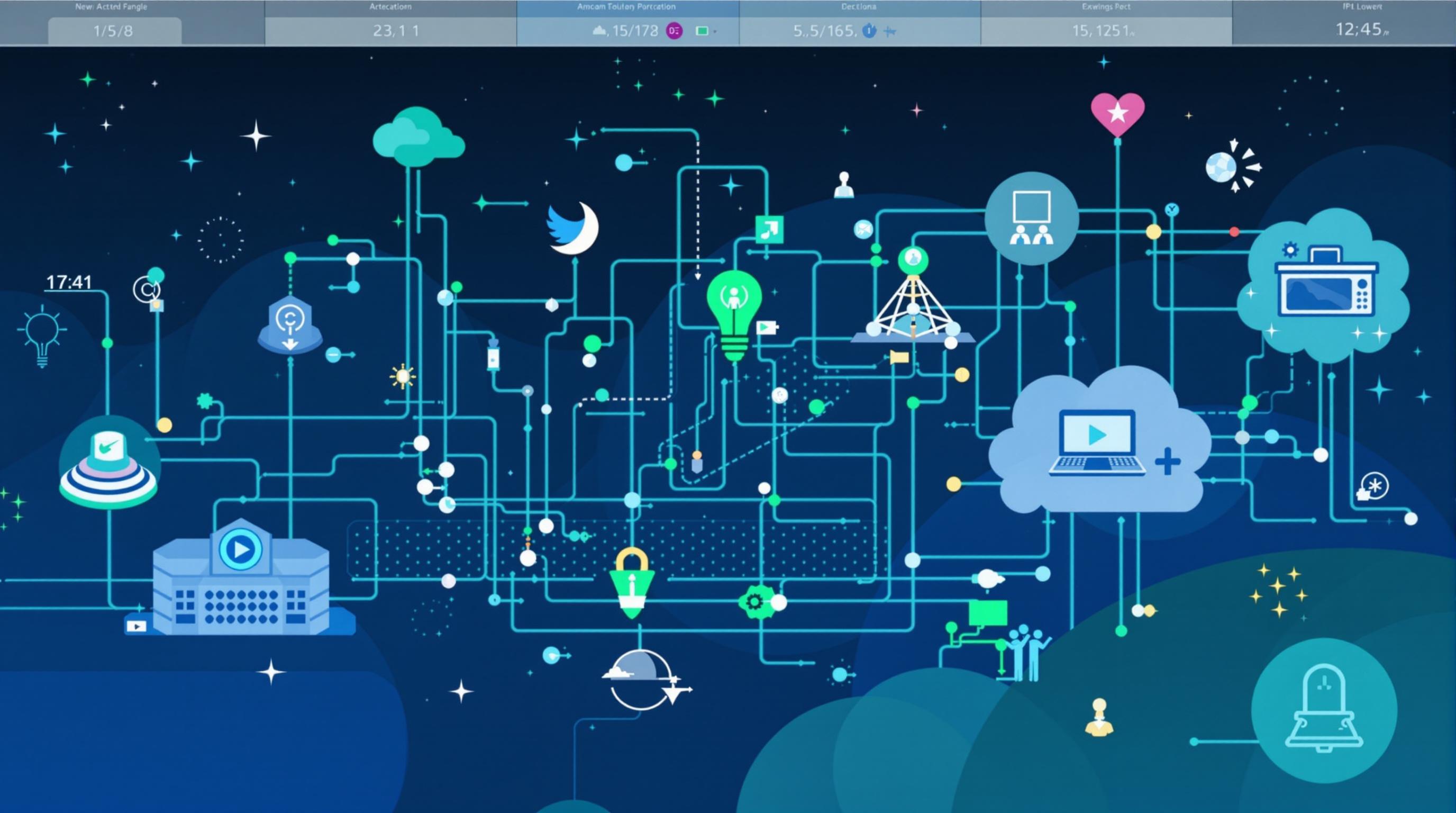Related Articles
- Harnessing Nostalgia: How Memory Mapping Can Inspire Innovative Urban Infrastructure Solutions
- Revealing the Invisible: How Urban Legends Influence Public Perception of Infrastructure Projects
- Whimsical Structures: How Playgrounds Can Inspire Innovative Approaches to Urban Infrastructure Development
- The Enigmatic Impact of Dark Fiber Networks on the Future of Digital Ecosystems and Their Capacity to Scale
- Beyond the Horizon: Exploring the Impact of Cultural Nuances on Global Digital Infrastructure Expansion
- Whispers of the Future: How AI-Driven Edge Computing Redefines Network Resilience and Flexibility
11 Quirky Innovations: How Microservices Architecture Unlocks Novel Pathways for Internet Scalability Solutions
11 Quirky Innovations: How Microservices Architecture Unlocks Novel Pathways for Internet Scalability Solutions
Introduction to Microservices Architecture
In today's digital era, scalability is crucial for any internet-based business. Traditional monolithic architectures often struggle to adapt quickly to changing demands and user growth. Enter microservices architecture—a design approach that disaggregates applications into smaller, self-sufficient services that communicate through APIs. This innovative model not only enhances scalability but also enables teams to work independently on different services.
Microservices architecture allows each component of an application to be developed, deployed, and operated independently. This autonomy means that individual teams can utilize different technologies and programming languages best suited for their specific service, thus fostering innovation and efficiency. The flexibility of this approach caters to the diverse needs of modern applications, especially those facing high traffic and variable workloads.
By embracing microservices, organizations can mitigate risks associated with system failures. If one service fails, it does not bring down the entire system, significantly enhancing the overall robustness of internet applications. Consequently, users experience fewer disruptions, and businesses can maintain continuous service delivery, which is critical in today’s demand-driven market.
1. Enhanced Flexibility and Agility
One of the standout benefits of microservices architecture is the enhanced flexibility it offers. Each microservice can be developed and updated independently, allowing for rapid iterations and adjustments in response to user feedback or market trends. This agility is essential for companies looking to stay competitive in fast-paced environments.
Moreover, teams can adopt agile methodologies that align with microservices. For instance, continuous integration and deployment (CI/CD) practices can be seamlessly integrated into the development workflow, enabling more frequent updates and releases without the slowdowns associated with traditional software development cycles.
This level of responsiveness ultimately translates to a better user experience, as applications can evolve swiftly to meet changing consumer expectations. As a result, developers and businesses can experiment with new features and innovations, making iterative improvements that keep user engagement high.
2. Independent Scalability
Microservices architecture allows for independent scalability, which is fundamental for internet scalability solutions. Individual services can be scaled up or down based on their specific demand without affecting the entire application. This targeted resource allocation leads to more efficient utilization of server capacity.
For example, if an e-commerce application experiences a spike in traffic during holiday sales, only the cart and checkout services may need to be scaled up, while other services remain unaffected. This approach not only saves costs by avoiding unnecessary scaling of less active services but also ensures that resources are allocated where they are needed most.
Independent scalability also simplifies the integration of new service instances. Teams can add more instances of a microservice to handle increased load, allowing businesses to accommodate fluctuating demands seamlessly. This elasticity is particularly advantageous for cloud-based applications, which can dynamically adjust resources based on real-time metrics.
3. Technology Diversity
One of the most exciting aspects of microservices is the opportunity for technology diversity. Different services within a microservices architecture can leverage various programming languages, databases, frameworks, and tools. This flexibility empowers development teams to choose the most appropriate technologies tailored to specific service functionalities.
For instance, a data-heavy service might utilize a NoSQL database for optimized performance, whereas a computationally intensive service may benefit from a language like Python or Rust. This diversity fosters a culture of innovation, encouraging teams to explore and implement the latest technologies and methodologies that can contribute to improved service delivery.
Additionally, employing multiple technologies can help to prevent vendor lock-in, as organizations are not tied to a single technology provider. This strategic diversity makes it easier for businesses to pivot and adapt their technology stack as new solutions emerge, ensuring they remain on the cutting edge.
4. Robust Fault Isolation
Fault tolerance is a critical consideration for any scalable internet solution. Microservices architecture enhances fault isolation by ensuring that failures in one service do not propagate throughout the entire application. When a microservice encounters issues, other services continue to operate independently, preserving the overall functionality of the system.
This isolation allows for more effective monitoring and debugging as teams can focus on specific services. By utilizing centralized logging and tracing, organizations can swiftly identify and resolve issues within individual microservices, leading to faster recovery times and improved reliability.
Incorporating circuit breakers and fallback mechanisms can further enhance resilience. For example, if a service becomes temporarily unavailable, circuit breakers can prevent repeated calls, allowing the system to maintain performance and stabilize until the service is restored. Such strategies contribute to a more robust architecture that can withstand unexpected failures.
5. Simplified Deployments
With microservices architecture, deployment becomes a more manageable and streamlined process. Each microservice can be deployed independently without requiring a full redeployment of the entire application. This modular approach significantly reduces downtime during releases, enabling organizations to roll out new features and updates faster.
Continuous Deployment (CD) practices can be easily integrated into a microservices framework. Automated testing and deployment pipelines mean that changes made to a service can be automatically pushed to production as soon as they pass quality checks. This not only improves delivery speed but also ensures consistency across the deployment process.
This simplified deployment strategy becomes increasingly valuable as applications scale. As development teams grow and more microservices are added, the complexity of traditional deployment methods can lead to errors and increased lead times. Microservices mitigate this risk by ensuring that services are independently manageable and maintainable.
6. Improving Development Productivity
Productivity is a key metric in software development, and microservices architecture significantly enhances it. By allowing teams to specialize in individual services, organizations can foster expertise and efficiency among their developers. As team members become adept at managing specific components, overall development throughput increases.
Moreover, teams can work in parallel without being impeded by interdependencies. One team can develop a new feature for a microservice while another team addresses bugs or refines existing functionality in another service. This parallel development reduces bottlenecks and accelerates time-to-market for new functionalities.
With the microservices approach, teams can also adopt DevOps practices more easily, enabling tighter collaboration between development and operations. As teams automate more processes, they can unlock additional productivity gains, driving innovation at a faster pace while ensuring that application quality remains high.
7. Streamlined Maintenance
Maintenance of applications can be a daunting task, especially as systems grow larger and more intricate. However, microservices architecture simplifies maintenance by breaking applications into smaller, manageable components. Each microservice can be updated or replaced independently, allowing for focused maintenance efforts without impacting the entire system.
This streamlined maintenance approach means that developers can roll out updates for specific services without needing to re-test or re-deploy the entire application. Such independence minimizes the risk of introducing unintended side effects during updates, enhancing overall stability.
Additionally, the modularity of microservices allows organizations to adopt an iterative approach to maintenance. Legacy services can be phased out or rewritten as new microservices, facilitating gradual improvements to the architecture without massive overhaul efforts.
8. Better Resource Management
Microservices architecture enables better resource management through its distributed nature. Instead of allocating resources based on the needs of an entire monolithic application, microservices allow resources to be tailored to the specific requirements of individual services. This targeted approach mitigates waste and encourages efficient use of computing power.
Containerization technologies, such as Docker and Kubernetes, complement microservices by allowing developers to pack services with their dependencies while being resource-efficient. Cloud services can dynamically allocate infrastructure resources based on actual service demand, optimizing cost and performance.
Additionally, effective monitoring and resource tracking mechanisms enable organizations to make informed decisions on resource allocation. By understanding the workload patterns of each microservice, management can proactively scale resources to avoid performance degradation during peak usage times.
9. Improved Security Posture
Security is a top priority for any organization operating online, and microservices architecture can bolster an application's security posture. In a microservices setup, applications are segmented into discrete services, enabling more granular security controls and policies. This isolation inherently reduces the surface area for potential attacks.
Each microservice can implement specific security measures tailored to its functionality. For example, services that handle sensitive user data can employ strict access controls and encrypted communication, while less critical services might adopt lighter security measures. This layered security approach helps protect the system holistically.
Furthermore, adopting centralized authentication mechanisms (e.g., OAuth) ensures that user identity management remains consistent across services. By addressing security at the microservice level, organizations can enforce best practices and respond quickly to threats, building trust with users and mitigating potential risks.
10. Facilitating Innovation
Microservices architecture inherently encourages a culture of innovation within organizations. The ability to implement changes and roll out new features independently fosters an environment where experimentation and risk-taking are highly encouraged. Organizations can prioritize innovation without jeopardizing the integrity of their entire application.
As teams can work independently on various aspects of an application, this division of labor allows for greater creativity and exploration of new ideas. Innovative solutions can be rapidly prototyped within a microservice and assessed for viability before full-scale implementation.
This innovative spirit is essential in industries that face constant disruption. Organizations leveraging microservices can pivot quickly in response to emerging trends and incorporate cutting-edge technologies, keeping them a step ahead of the competition and continuously enhancing user engagement.




